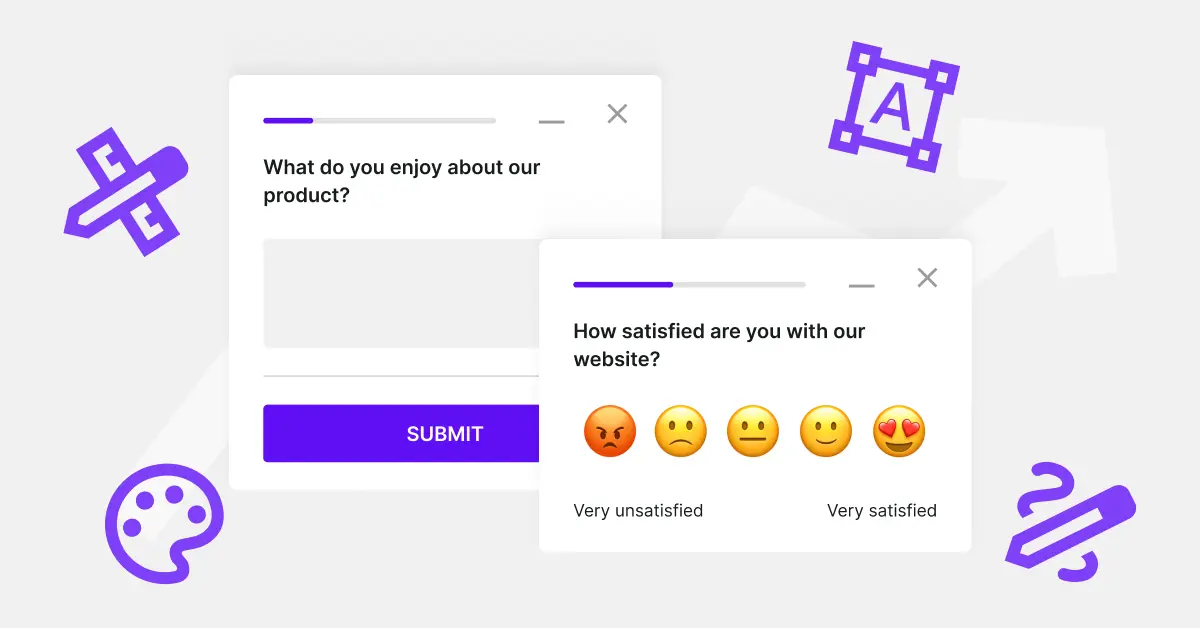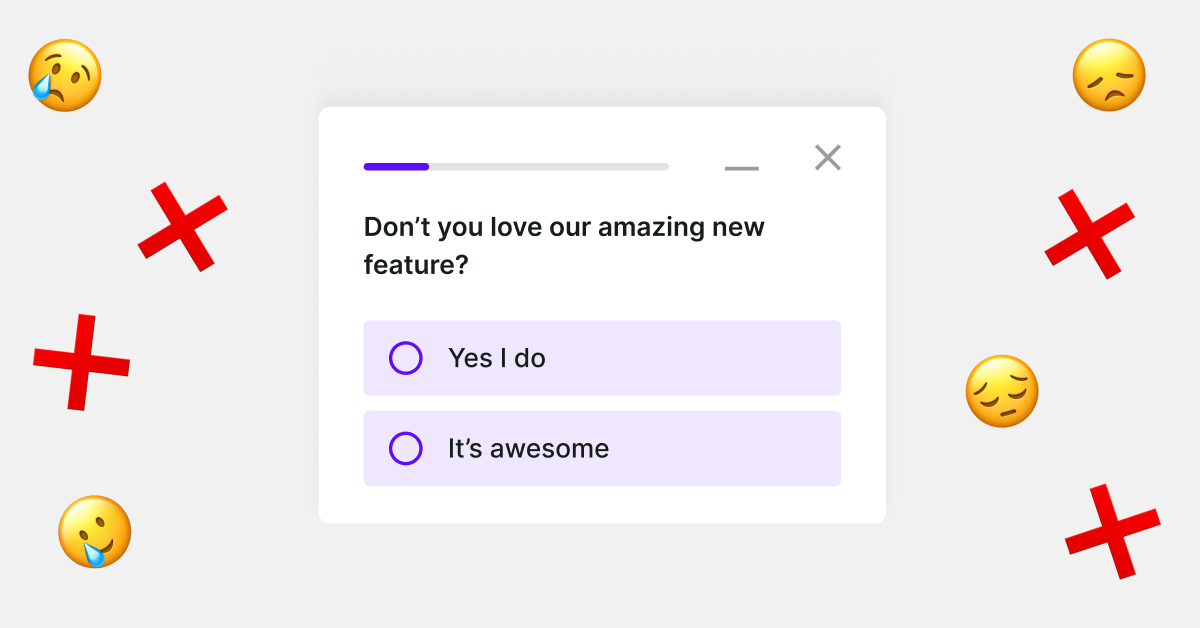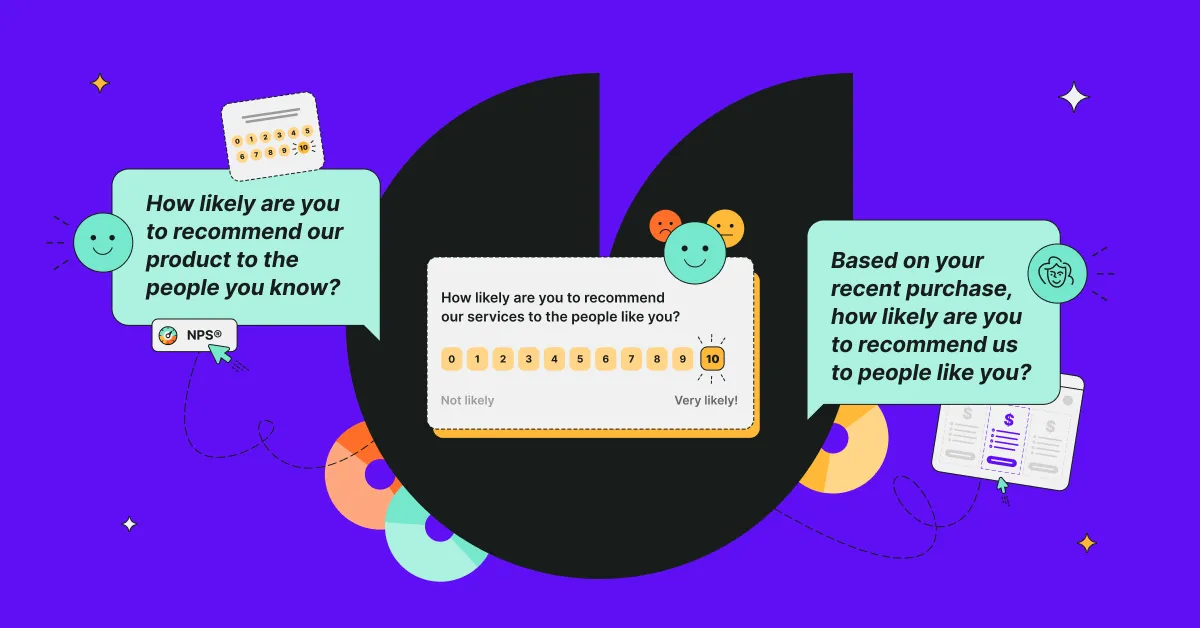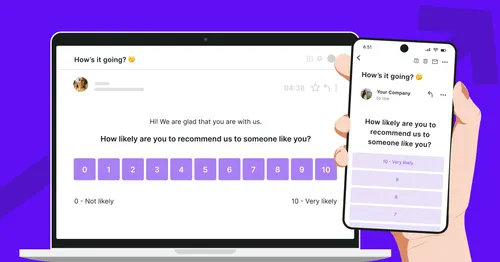tl;dr
- Understand the Purpose: Identify the objective of your rating scale (e.g., measuring brand loyalty or customer satisfaction) and choose the scale type (e.g., Likert Scale, Numeric Rating Scale, Comparative Scale) that best fits your product research goals.
- Design Considerations: Select the right scale (e.g., Graphic Scale, Descriptive Scale, Numerical, Shape, Smiley, NPS, Matrix, Likert Scale) and number of points. Consider which one from all types of rating scales suits your goal best. Ensure the scale is clear and easy to understand to prevent data misinterpretation.
- Best Practices: Ensure clarity in question-wording and scale options to reduce bias and misinterpretation. Embedding the first question in email surveys can increase response rates. Optimize timing and survey length for better engagement.
- Analyze Survey Results: Aggregate data to identify trends, use filtering to segment responses, and combine quantitative scores with qualitative feedback for comprehensive insights. Utilize AI tools for efficient analysis and actionable conclusions.

Introduction to Rating Scales
Have you ever been asked to rate your experience after a purchase or provide feedback on a service? If so, you've interacted with rating scales. These tools are fundamental for quantifying subjective experiences, attitudes, and opinions.
A rating scale can be as simple as a series of numbers or as complex as a descriptive emotional gauge. Its purpose is to translate qualitative data into quantitative insights. Understanding how to interpret these scales is invaluable as a business leader, researcher, or evaluator. They can reveal customer satisfaction levels, gather employee feedback, or measure the effectiveness of a program. By mastering the use of rating scales, you're unlocking a world of data-driven decision-making.
Types of Rating Scale Questions
Delving into the world of rating scales, you'll find a variety of types of rating scales, each suited for specific scenarios.
The Likert Scale is a popular choice in surveys, presenting you with a statement and asking for agreement on a five or seven-point rating scales, ranging from "strongly disagree" to "strongly agree."
The Numerical Rating Scale is straightforward, typically ranging from 0 to 10, allowing for a quick quantification of satisfaction or performance. A numerical rating scale provides respondents with a set of numbers that represent different levels of intensity or satisfaction, which they can use to rate their experience or perception.
The Visual Analog Scale is more abstract, often used in healthcare to measure pain by having you mark a point along a line that represents a continuum of sensation. When creating surveys, you can use emojis as a graphic rating scale to evaluate customer satisfaction from experience, purchase or other touchpoint.
The Net Promoter Score (NPS) is a widely-used rating scale that asks customers to rate their likelihood of recommending a company or product on a scale from 0 to 10, which helps businesses gauge overall customer satisfaction and customer loyalty. With NPS scale, customers are typically asked how likely they are to recommend a product or service to a friend.
Lastly, the Comparative Rating Scale is invaluable when preferences between items from two categories must be assessed, forcing a choice and thus revealing relative positions in customer perception. For example, a Comparative Rating Scale might be used in a consumer electronics survey where participants are asked to compare different smartphone brands. The scale could present statements like "Brand A has better battery life than Brand B" and "Brand C has a better camera than Brand A," with options ranging from "Strongly agree" to "Strongly disagree."
Designing an Effective Rating Scale
Crafting an effective rating scale requires careful consideration. First, pinpoint the rating scale's purpose. Are you looking to measure customer satisfaction, employee engagement, or something else entirely? Once the goal is clear, choose one from all types of rating scales that best facilitates your data collection.
In modern survey tools, you will be able to choose from a variety of rating scale types. In Survicate, you can use:
- Numerical Scale Question. This rating scale can contain up to 10 points.
- Shape Scale Question. This rating scale can contain up to 9 points. You can choose between the thumbs, hearts or star ratings.
- Smiley Scale Question. You can choose between a 3-point or 5-point graphic rating scale when choosing Emojis Scale. Relevant emojis will illustrate each answer option.
- Classic CSAT with Text Buttons. This is a descriptive rating scale where you can use any text as an answer option.
- NPS Question. This standard rating scale question enables survey takers to select the rating from 0-10 point rating scale.
- Matrix Question. This can be used as a rating scale question if you want to ask respondents about evaluating a few options simultaneously.
The number of points on the rating scale is also critical; too few may not capture nuances, while too many can overwhelm respondents. An odd number of points can provide a neutral option, while an even number forces a more definitive stance.
Remember, the design of your rating scale can significantly impact the quality and actionability of the data you gather.
Best Practices for Using Rating Scales
When utilizing rating scales, clarity is crucial. Each option on the rating scale question must be defined with precision to avoid misinterpretation. It's essential to avoid leading or loaded questions that could introduce bias and invalidate your data.
You want to ensure that the responses you collect are a true reflection of the respondent's feelings or opinions. Additionally, consider the rating scale's layout; it should be visually accessible and straightforward, ensuring that all respondents can easily understand and use it.
For email surveys, consider embedding the first question into the email message. This can significantly influence the response rates and engage more customers to rate your product or services. Consider the timing and triggers for your rating scale survey to reach the relevant audience at the best possible time.
When analyzing feedback, take note of the distribution of responses and be mindful of central tendency bias, where respondents may avoid extreme responses and lean towards the middle of the scale.
Rating Scales in Customer Research
In customer research, rating scales are essential for gathering relative information on different aspects of consumer experience. These scales allow researchers to assess criteria such as product satisfaction and service quality.
Respondents can quickly provide feedback, saving their time while offering valuable insights. Examples of rating scales include ordinal scale, where response options have a meaningful order, and graphic rating scales, which visually represent levels of satisfaction. Verbal rating scales use descriptive words to capture feelings about a service or product.
By employing these tools, businesses can compare customer perceptions across various dimensions, ensuring a comprehensive analysis of market position and consumer preferences. When designed effectively, rating scales can yield rich data to inform strategic decisions.

Common Mistakes to Avoid with Rating Scales
While rating scales are powerful tools, certain mistakes can compromise their effectiveness.
Ambiguity in wording can lead to inconsistent and unreliable data, as respondents may interpret the rating scale differently. Avoid overly complex rating scales that can cause confusion or discourage honest responses.
Choose the best channel for your rating scale survey questions. Depending on what you'd like to measure, you can choose from links, email, website, in-product or chat surveys.
To have better chances at collecting a lot of valuable insights, avoid creating long surveys with several questions. In most cases, the rating scale question and one follow-up question are sufficient to provide you with actionable details about your customers' experiences or needs.
It's also crucial to test your rating scale before widespread use to ensure that it is understood and measures what it's intended to. Ensure that the rating scale is culturally appropriate and free from language that could be misinterpreted.
By avoiding these common mistakes, you can ensure that your rating scale provides clear, actionable data that reflects true sentiment or assessment. What's more, you have a better chance of increasing your response rate and get more insights to work with.
How to Analyze Data from Rating Scales
Analyzing data from rating scales requires a systematic approach to extract meaningful insights.
Begin by aggregating the data to see overall trends, such as the mean, median, and mode of responses. This provides a snapshot of the central tendencies in the data.
For example, if you're measuring customer satisfaction with a product, the average rating can indicate general satisfaction levels.
Most survey tools will do that for you, so you won't have to perform much manual work. Consider implementing a customer feedback analysis tool supported with AI, so crucial conclusions are categorized and prioritized for you.
Next, evaluate the distribution to understand the variability in responses. Are there outliers or clusters of similar ratings?
Filtering options can refine your analysis. Segment the data by demographics, purchase history, or other relevant factors to uncover patterns. For instance, you might find that satisfaction ratings are higher among repeat customers.
Consider adding follow-up to rating scale questions to provide context to the numerical ratings, as they can reveal the reasons behind a score, offering qualitative data that complements the quantitative ratings. By cross-referencing quantitative scores with qualitative feedback, you can pinpoint specific areas for improvement or strengths to leverage.
Wrapping up
In conclusion, utilizing a rating scale in your surveys presents endless ways to engage customers and gather quality feedback. Whether you aim to create surveys that are extremely easy for respondents to complete or delve into more nuanced questions, the choice of response options can make this task straightforward.
Answer options should be carefully considered to avoid ambiguity and ensure clarity, thus making the survey experience as user-friendly as possible. By implementing these best practices, survey creators can effectively engage respondents, yielding high-quality data that reflects true sentiment.
Remember, the goal is to use a rating scale that measures what is intended and resonates with survey respondents.
Engage more customers with multichannel Survicate surveys. You can try it out starting today, no credit card is required – sign up for a free trial.













.svg)

.svg)



